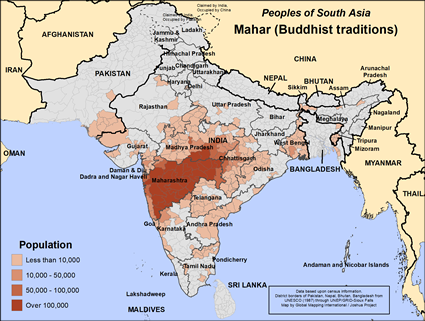Mahar (Buddhist traditions) in Pakistan

Photo Source:
Anonymous
|

Map Source:
People Group data: Omid. Map geography: UNESCO / GMI. Map Design: Joshua Project
|
| People Name: | Mahar (Buddhist traditions) |
| Country: | Pakistan |
| 10/40 Window: | Yes |
| Population: | 10,000 |
| World Population: | 9,628,000 |
| Primary Language: | Sindhi |
| Primary Religion: | Hinduism |
| Christian Adherents: | 0.00 % |
| Evangelicals: | 0.00 % |
| Scripture: | Complete Bible |
| Ministry Resources: | Yes |
| Jesus Film: | Yes |
| Audio Recordings: | Yes |
| People Cluster: | South Asia Dalit - other |
| Affinity Bloc: | South Asian Peoples |
| Progress Level: |
|
Introduction / History
The Mahar people were historically a part of a low caste, the lowest caste in the social system. This classification caused the Mahar people to face extreme discrimination and legal restrictions on day-to-day activities, out of the fear that they might contaminate higher caste. These restrictions included items such as when they were allowed to be in the city, whether they were allowed to spit on the ground, and how loudly they were allowed to talk. The Mahar people worked primarily as low-skilled laborers and speak the Marathi language.
Beginning around 1900, the Mahar people experienced a slow social revolution where they began to become aware of and fight for more rights due to British influence. This culminated in the conversion of close to 500,000 Mahar individuals to Buddhism in 1956 led by Bhimrao Ramji Ambedkar. Those that converted to Buddhism are typically not associated with the Mahar people group any longer.
Where Are they Located?
The Mahar people are primarily located in the Indian state of Maharashtra, which is named after them. They can also be found in the surrounding Indian states. There are also small Mahar communities that can be found in Pakistan and Bangladesh. Originally, the Mahar people lived in primarily rural communities, but now are also common in urban areas.
What Are Their Lives Like?
In 1949, the Indian constitution outlawed discrimination against the lowest social class. While this has helped the situation of those formerly in the low class, such as the Mahar people, they still face frequent residual discrimination.
Around the same time as the revolution led by Ambedkar, the Mahar people began to migrate to cities in search of work. They are often employed in low skilled labor such as masons, railway workers, bus/truck drivers, etc. In the rural areas, some Mahar people farm, though the Mahar people have never been an agricultural people group, likely due to their restricted access to land ownership.
What Are Their Beliefs?
There have been small successes in evangelizing to the Mahar people, particularly during the social revolution around 1960. This led to small population of Christians amongst the Mahar.
What Are Their Needs?
Due to their historical and continual discrimination, the Mahar people face an uphill battle in daily life. Many struggle to obtain all the necessities of life. The Mahar people need both economic and social justice, in order to thrive.
Additionally, they need a spiritual revival. The country of India and the Hindu religion are not very tolerant to Christianity and converts. Christian Mahars will often face even further persecution or discrimination than what they experienced previously as Hindus.
Prayer Points
Pray that God will begin restorative justice amongst the Mahar people, both socially and economically.
Pray that God will raise up missionaries that have a heart for the Mahar people.
Pray that God will soften the hearts of the Mahar people and that they will be responsive to the Gospel.
Pray that God will establish a thriving church amongst the Mahar people and will give the current Christians the strength to persevere and continue evangelizing.
Pray for protection for the Mahar Christians from persecution.